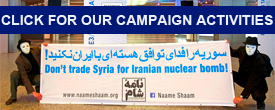The following narrative and policy recommendations are based on three in-depth reeports by Naame Shaam (henceforth ‘the Reports’):
Iran in Syria: From an Ally of the Regime to an Occupying Force (November 2014)
Silent Sectarian Cleansing: Iranian Role in Mass Demolitions and Population Transfers in Syria (May 2015)
Financing Terror – The Economic Impact of Iran’s Nuclear Programme and its Support to Paramilitary Groups across the Middle East (December 2015).
The Reports are the result of two years of Naame Shaam’s work. They draw largely on information gathered from monitoring Syrian, Iranian and international media’s coverage of events in Syria. The majority of the information and sources found in the Reports are thus in the public domain.
What we did was to ‘connect dispersed pixels’ to create clear, meaningful images and use these as a basis for the new narrative and policy recommendations below.
I. POLICY RECOMMENDATIONS
1. Treat regime-held areas in Syria as territories occupied by the Iranian regime and its militias
→ Publicly acknowledge that the war in Syria is a war that, first and foremost, involves the Iranian regime and the militias under its control (Hezbollah Lebanon, Iraqi, Afghan and Pakistani Shia militias), with the support of Russian war planes and ground forces.
→ Treat the war in Syria as an international armed conflict that involves a foreign military occupation by Iran and Russia on the one hand and a liberation struggle by the Syrian people against this foreign occupation on the other.
2. Bases of balanced negotiations with Iran
→ End the ‘slow bleeding’ policy towards the Iranian regime and Hezbollah Lebanon in Syria and adopt another, more sustainable strategy (see below).
→ Publicly state that the Syrian and the Iranian regimes have been facilitating and using terrorist groups such as ISIS. The August 2014 UN resolution on ISIS already authorizes taking action against these regimes for their support of these groups.
→ Tell Iranian negotiators during the ongoing Syria peace talks in Vienna that Iran should pull its Sepah Pasdaran, Hezbollah Lebanon and the Iraqi and Afghan militias out of Syria.
→ Keep the Iranian regime under strong political and economic pressure, not only until if fully gives up its military nuclear program, but also until it ends in destabilizing policies in the Middle East.
→ Add all Iranian officials and entities linked to criminal and terrorist acts committed in Syria to the US and EU’s terrorism black lists and sanction them accordingly. These should include Sepah Pasdaran and its foreign operations arm Sepah Qods, the Iranian Basij force, Hezbollah Lebanon, Abu al-Fadl al-Abbas Brigade and other Iraqi, Afghan and Pakistani militias fighting in Syria.
3. Investigate Iranian role in war crimes and crimes against humanity
→ Hold the Iranian regime accountable for the repeated breaches of its duties as an occupying force in regime-held areas in Syria, in line with the Fourth Geneva Convention.
→ Independent international bodies should investigate the possible complicity of the Iranian regime, particularly Sepah Qods and its chief General Qassem Solemani, in various war crimes and crimes against humanity committed in Syria.
→ Refer the situation in Syria to the International Criminal Court (ICC) in The Hague to investigate all war crimes and crimes against humanity committed in Syria, including Iran’s and Hezbollah’s role.
4. Concrete steps to end the bloodshed in Syria and the wider region
→ Russia should be pressured with more economic sanctions and diplomatic isolation so that it disengages from Iran and becomes part of the solution in Syria, rather than being part of the problem.
→ The US and its allies should demand from the Iranian regime to take the following steps or face serious consequences:
- Pull all its Sepah Pasdaran, Hezbollah Lebanon and other foot soldiers out of Syria;
- End its financial and military support to the Syrian regime;
- Order Hezbollah Lebanon to disband its military wing and integrate its fighters with the Lebanese army, and end all financial and military support to Hezbollah;
- Allow the formation of a truly inclusive government and army in Iraq, and order all the Iraqi Shia militias it controls to disband;
- End its financial and military support to the Huthi militias in Yemen;
- End its financial and military support to extremist Palestinian factions in the Gaza Strip (Hamas and the Islamic Jihad).
→ In parallel, the US and its allies should arm and train enough moderate Syrian rebels, not only to fight Daesh (so called Islamic State) and al-Qaeda-linked groups, but also Syrian and Iranian regime forces and militias.
→ The US and its allies should also put all their weight behind helping the Syrian opposition develop into a professional and effective representative of the Syrian people struggling for a free and democratic state where the rule of law prevails. This political and military support should be provided through one unified channel supervised by the US and the EU, rather than leaving it to various regional and international players with conflicting agendas.
→ If the Iranian regime fails to implement the above mentioned demands, the US and its allies should put on the table a UN Security Council resolution under Chapter VII imposing safe and unhindered humanitarian access to conflict zones and people in need throughout Syria.
→ If Russia and China veto this, then the US and its allies should act unilaterally by securing rebel-held areas, imposing no-fly zones and imposing an arms embargo against the Syrian regime in order to protect the Syrian people from war crimes, crimes against humanity, genocide and ethnic cleansing.
→ The US and its allies should act in line with the Responsibility to Protect norm (R2P):
- A state has a responsibility to protect its population from genocide, war crimes, crimes against humanity and ethnic cleansing.
- The international community has a responsibility to assist a state to protect its citizens.
- The al-Assad regime and its Iranian and Russian supporters have manifestly failed to protect the Syrian population from mass atrocities and all diplomatic measures have failed. The international community therefore has a responsibility to intervene through coercive measures such as economic sanctions and military intervention.
- R2P is a norm and not a law; but it is firmly grounded in international law, especially the laws relating to sovereignty, peace and security, human rights and armed conflicts.
The US is the only global power capable of leading an alliance against the destabilizing policies of the Iranian regime and against extremist groups like Daesh and Jabhat al-Nusra. No other country can mobilize the necessary resources and exert the required political pressure.
Naame Shaam believes that only a serious threat to use all necessary measures against Iran will force the Iranian regime to end its destabilizing policies in Syria, Iraq, Lebanon and Yemen and give up, once and for all, its quest for the nuclear bomb.
Any other ‘soft’ approaches are likely to fail and will only lead to Sepah Pasdaran’s expanding its dominance in the region. This, in turn, will eventually allow the Iranian regime to impose itself as a nuclear power because nobody can then stop it from having the nuclear bomb.
II. NEW NARRATIVE
1. The Iranian regime is complicit in Syria war crimes and crimes against humanity
The Reports provide many examples of human rights violations, war crimes and crimes against humanity committed in Syria by the al-Assad regime with the support and complicity of the Iranian Revolutionary Guards (Sepah Pasdaran) and the militias they control in Syria. They also provide numerous examples and case studies of human rights violations, war crimes and crimes against humanity committed in Syria by Iranian-controlled militias and forces.
There is sufficient evidence to start investigations and bring lawsuits against the Iranian regime’s military and political leadership for complicity in many of these crimes at various levels, ranging from ‘inciting’, ‘endorsing and adopting’ specific criminal and terrorist acts to ‘aiding and abetting’ war crimes and crimes against humanity.
One of these international crimes is the systematic forced displacement of Syrian civilians and the destruction and appropriation of their property in certain parts of Syria, such as Damascus and Homs. A ‘silent sectarian cleansing’ is taking place in Syria while the world is silently watching.
The planned destruction and reconstruction of certain areas in Syria appears to have been intended to punish the communities supporting the revolution or the armed rebels, the majority of which happened to be Sunni. It also aims to ‘cleanse’ those areas of all ‘unwanted elements’ and prevent them from returning home in the future, and replacing them with Syrian Alawis and foreign nationals of Shia origin who support the regime.
This sectarian cleansing is dramatically changing the demographic composition of some parts of Syria. The ultimate aim of this scheme appears to be securing the Damascus-Homs-Coast corridor along the Lebanese border in order to both provide a geographical and demographic continuity of regime-held areas and secure arms shipments to Hezbollah in Lebanon.
The highest levels of the Syrian regime, as well as Iranian and Hezbollah Lebanon leaders and businessmen, are implicated in these war crimes and crimes against humanity.
2. Sepah Pasdaran and Hezbollah are fighting and directing all major battles in Syria
It is no longer accurate to describe the war in Syria as a ‘conflict’ between Syrian rebels on the one hand and Bashar al-Assad’s regime forces ‘supported’ by Sepah Pasdaran, Hezbollah Lebanon and Iraqi and Afghan militias on the other.
All major, strategic battles in Syria – along the frontlines of regime-held areas – are now being fought and directed by Sepah Pasdaran and Hezbollah Lebanon, rather than the al-Assad forces.
The Iranian regime’s military involvement in the ongoing war in Syria has gradually grown from providing strategic and technical support to being in overall control of the Syrian regime’s military strategy and directing all its major military campaigns.
3. The Iranian regime is propping up the Syrian regime’s economy
The Iranian regime has been spending billions of dollars on weapons and fighters shipped to Syria since the start of the Syrian revolution in March 2011, as well as financing a big part of the economy in the regime-controlled parts of Syria through financial loans and credit lines worth billions of dollars.
The al-Assad regime would have collapsed a long time ago if it was not for this Iranian support.
Since the outbreak of the Syrian revolution in March 2011, Iran has been providing the Assad regime with US$ 3 to 5 billion annually. This ‘aid’ has contributed to the death of over 300,000 people, the displacement of more than seven million inside Syria and about four million to neighbouring countries.
Additionally, the Iranian regime has been providing Hezbollah Lebanon with US$ 100 to 200 million per year since the 1980s, not accounting for arms deliveries or special payments, such as rebuilding Shia areas in Lebanon after the 2006 war with Israel. Hezbollah is one of the main militias fighting in Syria on behalf of the Assad regime. Shia militias in Iraq, many of which are also fighting in Syria, received US$ 10 to 35 million annually between mid- and late 2000s. This increased to an estimated US$ 100 to 200 million annually as of 2009.
Iran also provided the Palestinian Hamas with US$ 100 to 250 million between 2007 and 2011. The Palestinian Islamic Jihad received US$ 100 to 150 million annually since 2007. The Houthi militia in Yemen received US$ 10 to 25 million since 2010, partly in cash but mostly in the form of training, advice and arms.
All in all, the Iranian regime’s lavish expenditure on financing terrorist activities and groups in Lebanon, Iraq, Syria, Palestine and Yemen, has totaled between US$ 20 and 80 billion since the 1980s.
Following the nuclear deal signed with Iran in July 2015 and the expected lifting of economic sanctions in 2016, the Iranian regime will have access to US$ 100-150 billion in 2016, in addition to new revenue from oil export. Some of this cash will be pumped into the country’s ailing economy, but a lot of the fresh dollars will certainly be used to finance the Iranian regime’s terrorist activities and destabilising policies in Syria and elsewhere in the Middle East.
We expect the focus of Iran’s financing of terror in 2016 to be Syria, Lebanon and Iraq.
4. Syria is partly under Iranian military occupation
The massive military and economic support provided by the Iranian regime to Bashar al-Assad’s regime has led to a de facto military occupation by the Iranian regime of the so-called regime-held areas in Syria. These areas are under the total control of Sepah Pasdaran and their foot soldiers like Hezbollah Lebanon.
The chief of Sepah Qods, Gen. Qassem Soleimani, and a few other commanders from Sepah Pasdaran are today the de facto rulers of ‘Iranian-occupied Syria’. Bashar al-Assad and his regime are little more than puppets in their hands.
This reality has political as well as legal implications. The Reports detail legal arguments for treating the war in Syria as an international armed conflict that involves a foreign military occupation by the Iranian regime and its militias and a liberation struggle by Syrian people against this foreign occupation, as defined by the 1907 Hague Regulations and the 1949 Geneva Conventions.
Recognizing the war in Syria as an international conflict also means that, as an occupying force, Iran has certain ‘duties’ towards the Syrian population under its occupation, according to the Fourth Geneva Convention.
There is sufficient evidence that the Iranian regime and its various forces and militias fighting in Syria have repeatedly violated many of these duties since March 2011. These violations are considered serious war crimes, just like those mentioned above.
5. Russian intervention to save Iran and Hezbollah
Before the escalation of its military intervention in the Syria war in late September 2015, Russia had been supplying the Syrian regime with weapons and shielding it diplomatically by repeatedly using its veto powers at the UN Security Council. But its support did not prevent rebels and Islamist factions from making significant military advances over the previous few months, especially in the southern and northern parts of the country.
Russian officials insist that the deployment of Russian airplanes and troops to Syria came as a result of “a formal request” from President Bashar al-Assad. But we now know that it was the Iranian regime that asked Russia to intervene to prevent al-Assad’s fall and prevent further losses suffered by Iranian forces and militias fighting on his behalf.
According to regional officials quoted by Reuters in early October 2015, the chief commander of Sepah Qods, Major-General Qassel Soleimani, visited Moscow in July 2015 and convinced his Russian hosts of how a series of defeats could be turned into victory “with Russia’s help.”
Soleimani’s July trip was preceded by high-level Russian-Iranian contacts that produced a political agreement on “the need to pump in new support for Assad as his losses accelerated.” The decision for a joint Iranian-Russian military effort in Syria had been taken at a meeting between Russia’s foreign minister and Iran’s Supreme Leader a few months before. “Soleimani, assigned by Khamenei to run the Iranian side of the operation, traveled to Moscow to discuss details.”
Shortly before the start of the Russian air strikes on 30 September 2015, hundreds of Sepah Pasdaran ground troops started arriving in Syria in preparation for a major ground offensive against rebel-held areas in the north-western parts of the country, under the cover of Russian air strikes.
The main aim of Russia’s direct military intervention in Syria was to provide air cover and support for ground operations by Iranian forces and militias. The agreement between Moscow and Tehran also included the provision of more sophisticated Russian weapons to the Syrian army and the establishment of joint operations rooms.
Russia’s direct military intervention in Syria may also help President Vladimir Putin to divert attention inside Russia from the deteriorating economic situation and corruption, as well as pressuring the US and the EU to lift their sanctions imposed on Russia following the latter’s annexation of Crimea and the occupation of Eastern Ukraine in 2014.
But both of these goals are largely contingent on the success of the first one, that is, Iranian forces and militias, with Russian air support, achieving significant military gains on the ground. So far little has been achieved in this respect beyond Russian and Iranian war propaganda.
6. The US strategy of of ‘slowly bleeding’ Iran, Hezbollah and Russia in Syria
The US administration’s strategy on Syria has so far mainly revolved around the ‘slow bleeding’ of Iran, Hezbollah and now Russia in a protracted battle. The rationale behind the strategy appears to be an assumption that a prolonged proxy war with the Iranian regime and Russia in Syria, coupled with crippling economic sanctions and falling oil prices, would eventually lead to weakening the Iranian regime and therefore force it to agree to scrap its military nuclear programme and end its destabilizing policies in Lebanon, Syria, Iraq, Yemen and elsewhere.
At best, this appears to be wishful thinking. Moreover, this ‘slow bleeding’ strategy is being implemented at the disproportionate expense of the people of Syria and the wider region, and is leading to more instability and extremism in the Middle East and beyond.
The US administration has promised that the nuclear deal will be fully implemented in 2016, or crippling economic sanctions against Iran will remain in place or will be reactivated. But what is President Barack Obama’s strategy to counter the expected rise in the Iranian regime’s financing of terror by the Assad regime, Hezbollah and the sectarian Shia militias in Iraq, Lebanon and Yemen, once US$ 100 to 150 billion of frozen Iranian assets are released in 2026?
7. The Iranian regime and the war on Daesh
The Reports examine the relationship between the Syrian and the Iranian regimes on one hand and Daesh (so-called Islamic State) and al-Qaeda-affiliated groups on the other. There is ample evidence that both the Syrian and the Iranian regimes have infiltrated, collaborated and used these terrorist groups to derail the Syrian revolution towards militarization and sectarianism and to justify their military actions against Syrian protesters and rebels.
This is significant as both regimes have been attempting to sell themselves as ‘partners’ in the international campaign against Islamist terrorist groups, following the UN Security Council resolution on Daesh and Jabhat al-Nusra in August 2014 and the US President’s declaration of war against Daesh in Iraq and Syria in September 2014.
Neither of these decisions explicitly mentioned the links of these groups with the Iranian and Syrian regimes. Now Russia, the main backer of both regimes, has taken a front seat in the supposed war against Daesh.
Meanwhile, moderate Syrian rebels are at the same time fighting:
- against the al-Assad regime and various foreign forces and militias that are fighting alongside and on behalf of the regime (Sepah Pasdaran, Hezbollah Lebanon, Iraqi, Afghan and Pakistani militias);
- against extremist groups such as Daesh and Jabhat al-Nusra; and more recently,
- against Russia.
Limiting the support provided to Syrian rebels to one of these fronts (fighting Daesh) is not working and is not sustainable in the long term.
8. US national and regional interests
The ‘slow bleeding’ policy and the US administration’s refusal to fulfil its promises of providing serious support to moderate Syrian rebels has led to the strengthening of extremist groups like Daesh and Jabhat al-Nusra.
People are dying and being displaced in their millions or joining these extremist groups as a result. This is not only a tragedy for the people of Syria, Lebanon and Iraq; it is also a serious threat to regional and international security, as the terrorist attacks in Beirut, Paris and elsewhere have shown in 2015.
The lack of hope and support is driving many Sunni Muslims in Syria and beyond to join Daesh and Qaeda-linked groups in the face of Iran’s sectarian policies in the region. Many Sunni Muslims believe that the US has sold out Syria (and Iraq) to Iran for the sake of the nuclear deal signed with Iran in July 2015. Even worse, many in the Middle East believe that the US has stopped caring about such values as freedom and human rights.
News of Western business delegations visiting Iran to sign new deals is further fueling the propaganda machine of Daesh. Empty promises by the US to seriously support moderate rebels are eroding what is left of Western credibility. Not acting decisively in Syria is making the situation worse by the day. Now Russia has stepped in, capitalizing on the West’s failure to act. The result is more radicalization and extremism, more terror, more refugees and a disintegrating Middle East. This cannot be in the interest of the US and its allies.
It cannot be in the interest of the US and its allies that the prevailing perception among many Syrian and Iraqi Sunnis now is that they are being left to die or left at the mercy of the sectarian, Iranian-controlled regimes and militias of Syria and Iraq, while the West is focusing on fighting Daesh.
It also cannot be in the interest of the US and its allies that moderate Syrian rebels have become significantly weaker than Daesh and Jabhat al-Nusra. The only ones benefiting from this are the Syrian and Iranian regimes.
9. Iranian ‘lines of defense’ to protect Iran’s military nuclear facilities
The main reason for the Iranian regime’s uncompromising determination to save Bashar al-Assad’s regime at any cost is to maintain its ability to ship arms to Hezbollah in Lebanon via Syria, so as to keep Hezbollah a strong deterrent against any possible Israeli and/or Western attacks on Iran’s nuclear facilities. The Lebanese-Israeli border is Iran’s main ‘line of defense’.
Following the Hezbollah-Israel war in the summer of 2006, marine vessels under a UN mandate have been preventing Iranian arms reaching Hezbollah via Lebanese ports (in line with UN Security Council resolution 1701 of 11 August 2006). Since then, the Iranian regime has been shipping arms and ammunition to Hezbollah Lebanon via Syrian ports. From there they are illegally transported into Lebanon. Syria has been the lifeline of Iran’s army in Lebanon, i.e. Hezbollah, since 2006.
Other Iranian ‘lines of defense’ include a number of Iranian-supported Iraqi Shia militias, the Iranian-supported Palestinian groups Hamas and the Islamic Jihad in the Gaza Strip (along Israel’s southern border) and the Iranian-supported Huthi Shia militia in Yemen (along the southern border of Saudi Arabia).
If the al-Assad regime falls, Iranian arms shipments to Hezbollah are likely to stop and Hezbollah would no longer be the threatening deterrence against Israel that it is now. The Iranian regime would therefore feel more vulnerable and would not be able to negotiate from a strong position during the ongoing Vienna negotiations with world powers, as it did during the nuclear talks. It may even have to give up its nuclear dreams for a while. All available resources in Iran (human, economic, military) have therefore been mobilized to achieve this strategic aim.
The Iranian involvement in Lebanon and in Syria is mainly about deterrence and creating the best possible situation for the Iranian regime to be able to build its nuclear bomb one day in order to guarantee its survival. The Iranian regime, represented by Iran’s Supreme Leader Ayatollah Ali Khamenei and Sepah Pasdaran, will not give up this dream easily, if ever.
 English
English  فارسی
فارسی  العربية
العربية 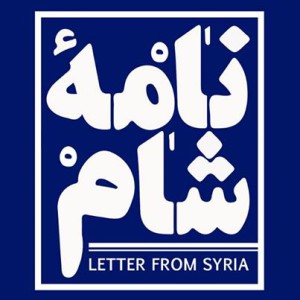
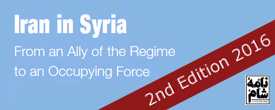
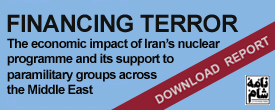
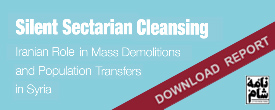
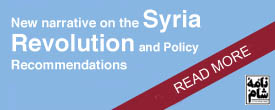

 On Twitter
On Twitter